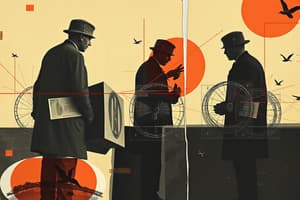Podcast
Questions and Answers
Which of the following best describes the recency effect?
Which of the following best describes the recency effect?
- The ability to recall the last items in a list due to them being in short-term memory. (correct)
- The difficulty in recalling information due to overload of data.
- The phenomenon where memory is significantly improved by distraction.
- The tendency to remember items presented at the beginning of a list.
Anterograde amnesia allows individuals to form new memories after the incident.
Anterograde amnesia allows individuals to form new memories after the incident.
False (B)
What phenomenon reduces the recency effect while recalling a list of items?
What phenomenon reduces the recency effect while recalling a list of items?
distractor tasks
Patient H.M. suffered from __________ amnesia, which prevented him from forming new memories.
Patient H.M. suffered from __________ amnesia, which prevented him from forming new memories.
Match the following memory phenomena with their definitions:
Match the following memory phenomena with their definitions:
What is the maximum capacity of short-term memory according to Miller’s theory?
What is the maximum capacity of short-term memory according to Miller’s theory?
Long-term memory has a limited duration.
Long-term memory has a limited duration.
What occurs in the short-term memory when information is rehearsed?
What occurs in the short-term memory when information is rehearsed?
According to the ________ Effect, items presented first are more likely to be remembered.
According to the ________ Effect, items presented first are more likely to be remembered.
What is the consequence of unattended information?
What is the consequence of unattended information?
Match the following terms with their descriptions:
Match the following terms with their descriptions:
What happens to recall ability after approximately 20 seconds without rehearsal?
What happens to recall ability after approximately 20 seconds without rehearsal?
Ebbinghaus demonstrated that recall probability is affected by the order in which items are presented.
Ebbinghaus demonstrated that recall probability is affected by the order in which items are presented.
What is the primary function of sensory memory?
What is the primary function of sensory memory?
Long-term memory has limited capacity.
Long-term memory has limited capacity.
What term describes the model that includes sensory, short-term, and long-term memory?
What term describes the model that includes sensory, short-term, and long-term memory?
In the multi-store model of memory, short-term memory has a _____ duration.
In the multi-store model of memory, short-term memory has a _____ duration.
Match the components of memory with their characteristics:
Match the components of memory with their characteristics:
According to the serial position effect, which part of a list is usually remembered best?
According to the serial position effect, which part of a list is usually remembered best?
Iconic memory refers exclusively to auditory stimuli.
Iconic memory refers exclusively to auditory stimuli.
Name one factor that affects the capacity of short-term memory.
Name one factor that affects the capacity of short-term memory.
Flashcards
Short-term memory capacity
Short-term memory capacity
The amount of information that can be held in short-term memory at any given time. Often referred to as 'magical number seven, plus or minus two'.
Short-term memory duration
Short-term memory duration
The length of time a piece of information can be held in short-term memory without rehearsal (conscious repetition).
Maintenance Rehearsal
Maintenance Rehearsal
Consciously repeating information to keep it in short-term memory.
Serial Position Effect
Serial Position Effect
Signup and view all the flashcards
Primacy Effect
Primacy Effect
Signup and view all the flashcards
Encoding
Encoding
Signup and view all the flashcards
Retrieval
Retrieval
Signup and view all the flashcards
Attention
Attention
Signup and view all the flashcards
Recency Effect
Recency Effect
Signup and view all the flashcards
Short-term memory (STM)
Short-term memory (STM)
Signup and view all the flashcards
Distractor task
Distractor task
Signup and view all the flashcards
Anterograde amnesia
Anterograde amnesia
Signup and view all the flashcards
Memory Stores Theory
Memory Stores Theory
Signup and view all the flashcards
What is iconic memory?
What is iconic memory?
Signup and view all the flashcards
How long does iconic memory last?
How long does iconic memory last?
Signup and view all the flashcards
What's the capacity of iconic memory?
What's the capacity of iconic memory?
Signup and view all the flashcards
Sperling's Experiment (Study 2)
Sperling's Experiment (Study 2)
Signup and view all the flashcards
What does Sperling's experiment tell us?
What does Sperling's experiment tell us?
Signup and view all the flashcards
Multi-store Model of Memory
Multi-store Model of Memory
Signup and view all the flashcards
What are the key differences between sensory, short-term and long-term memory?
What are the key differences between sensory, short-term and long-term memory?
Signup and view all the flashcards
What is the function of attention?
What is the function of attention?
Signup and view all the flashcards
Study Notes
Session Guidelines
- Engage actively in scheduled class content and activities.
- Maintain a respectful and focused atmosphere.
- Use only necessary devices.
- Commit to staying until the lecturer signals the end of class.
- Contribute positively and professionally.
- Approach sensitive topics with care.
- Choosing to stay demonstrates commitment to guidelines.
- Concerns or challenges following guidelines should be discussed with staff (e.g., advisor, course coordinator).
- Students who disrupt others' learning may be asked to leave.
Course Information
- The course is titled Psych 1A: Cognition.
- The lecturer is Dr. Judith Jackson.
- Contact email: [email protected]
- Log attendance on Moodle.
Memory Lecture 1
- The lecture covers the multi-store model of memory.
- Components of Baddeley's working memory model will be examined.
- The taxonomy of long-term memory is included.
Multi-Store Model of Memory
- Sensory input -> Sensory memory -> Short-term memory (STM) -> Long-term memory (LTM).
- Information not transferred is lost at each stage.
- Rehearsal moves information from STM to LTM.
- Atkinson & Shiffrin (1968, 2024) proposed this model.
Sensory Memory (Iconic Memory)
- Holds a brief trace of sensory input.
- High capacity.
- Short duration.
- Sperling (1960) studied iconic memory with visual stimuli.
Study 1 (Sperling, 1960)
- Task: participants saw an array of letters for 50 milliseconds and were asked to recall as many as possible.
- Results: Participants recalled about 3-4 letters, but reported remembering more.
- Conclusion: This suggests limited capacity and duration of sensory memory.
Study 2 (Sperling, 1960)
- Task: participants saw an array of letters and a tone was played indicating the row to recall.
- Results: Participants could recall almost all letters of the indicated row.
- Conclusion: High capacity and short duration of sensory memory were supported.
Short-Term Memory
- Miller (1956) found the capacity of STM is about 7 +/- 2 items.
- Peterson & Peterson (1959) found STM duration is limited (approx. 20 seconds without rehearsal).
Baddeley's Working Memory Model
- Central executive controls information flow, sets goals.
- Phonological loop processes verbal information.
- Visuospatial sketchpad manipulates visual and spatial information.
- Episodic buffer combines information from other components.
Long-Term Memory (LTM)
- Explicit memory (with conscious recall)
- Semantic memory: facts & general knowledge.
- Episodic memory: personally experienced events.
- Implicit memory (without conscious recall)
- Procedural memory: motor and cognitive skills.
- Priming: enhanced identification of objects or words.
Effects of Brain Damage
- Amnesia: inability to form (anterograde) or recall (retrograde) memories.
- Examples: Patient H.M. and Clive Wearing, both experienced amnesia due to brain damage.
Problems with the Multi-Store Model
- Evidence suggests working memory is not a unitary store, but rather comprises multiple systems (e.g., Baddeley's working memory model).
Student Hours
- Thursdays: 3pm - 4pm, Room 406, 62 Hillhead Street
- Mondays: 10.30am - 11.30am, online
Studying That Suits You
Use AI to generate personalized quizzes and flashcards to suit your learning preferences.




